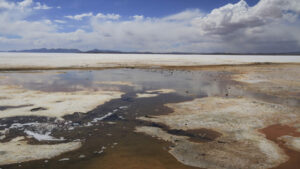Resources Top 5: These ASX rare earths juniors could be on the cusp of a big payoff

Pic: Getty Images
- Cosmos Exploration unearths several multi-kilometre REE trends at Byro East
- Desert Metals receives ‘outstanding’ high-grade REE results at Innouendy
- Stellar Resources receives exploration licence grant over prospective lithium and tin ground
Here are the biggest small cap resources winners in early trade, Wednesday November 2.
COSMOS EXPLORATION (ASX:C1X)
This RareX (ASX:REE) spin-off made its entry onto the ASX back in December 2021 with two projects in tow – the Byro East Nickel-Copper-PGEs Project in WA’s West Yilgarn region and the Orange East (gold) project in NSW.
But shares are flying sky high this morning on the reveal of ‘extensive rare earth element’ trends at Byro East.
Importantly, the company says these trends go for some several kilometres with a review of surface geochemistry returning values of up to 1,283ppm from a total of five rare earth elements as well as yttrium in clay-rich soils.
Cosmos says this breakthrough has added a significant new dimension to upcoming exploration activity in the region, which is emerging as an exploration hot spot for critical minerals.
The discovery of the Gonneville (Julimar) PGE-Nickel-Copper-Cobalt-Gold deposit by Chalice (ASX:CHN) back in March 2020 demonstrated the western margin of the Yilgarn craton is highly prospective for intrusion-related Nickel-Copper-PGE deposits.
“This is an exciting development for the project, particularly considering the significant clay-hosted REE discovery announced recently by Desert Metals, just to the north of Byro,” C1X managing director Jeremy Robinson says.
Follow-up exploration is currently being planned and re-assaying of samples from priority areas to obtain the complete rare earth element suite is underway.
DESERT METALS (ASX:DM1)
Rare earth sentiment is continuing its upward trajectory. In mid-2021 we counted ~15 REE focused stocks on the ASX; now there are +50 with new stocks added to the list daily.
DM1 was a standout play in September after first assays from a recent 12,745m drilling program at the Innouendy project returned numerous thick, shallow hits like 21m at 1176ppm from 4m.
This morning the company says new results ‘significantly’ expand the clay-hosted discovery at Innouendy with the best results including 20m at 1,834ppm from 20m and 16m at 2,059ppm from 32m.
Partial TREO (only the elements cerium+lanthanum+yttrium) assays have also been received from a number of holes with the full suite of REE results pending, the most significant hit being 31m at 1,701ppm from 32m including 8m at 3,536ppm.
“These results show that the new discovery stretches over a vast area, is thick and is high grade for clay style mineralisation,” DM1 managing director Rob Stuart says.
“We are very excited about what will be uncovered over the coming weeks and months as we begin our definition drilling and work towards defining a resource.”
STELLAR RESOURCES (ASX:SRZ)
SRZ has been granted an exploration licence over prospective lithium and tin ground in northeast Tasmania.
The area covers 97km in the Mt Paris and Scamander North areas, which SRZ executive director Gary Fietz says enhances the company’s commodity mix on top of its Heemskirk Tin Project and Victorian-style gold exploration targets.
An initial work program will be undertaken in Q1 2023 within the Mt Paris block focused on identifying lithium and tin targets via mapping, rock-chip and stream sediment sampling, searching for pegmatites which may occur near the Mt Paris Granite Margins.
AGUIA RESOURCES (ASX:AGR)
AGR has been granted a construction licence for its phosphate project in the southernmost state of Brazil, Rio Grande do Sul.
AGR says the construction licence is a critical milestone in the environmental permitting of the mine because it provides the necessary authorisation to initiate construction and start developing the mine site.
It also represents a substantial de-risking in the path to construction and production.
The project has a JORC-compliant measured and indicated resource of 83.21Mt grading 4.11% P2O5 and another 21.8Mt grading 3.67% P2O5 of inferred resource.
After the ramp-up period of the mine and processing plant, AGR expects to produce about 300 thousand tonnes of organic phosphate fertiliser per year over the 18-year life of mine and consume less than 5% of the resources.
LANTHANEIN RESOURCES (ASX:LNR)
(Up on no news)
Another rare earths junior with big potential, right on the door step of Hasting’s (ASX:HAS) Yangibana Project, as well as other players including Dreadnought (ASX:DRE), and Kingfisher Mining (ASX:KFM) in WA.
A recent reverse circulation (RC) program at the Lyons Project totalling 53 drill holes for 3,510m intersected prospective rare earth elements (REE) bearing ironstones at four key prospects – Lyons 11, 12, 13 and 27.
While visual results are no replacement for assays, the most interesting results came out of Lyons 27 in the north-western part of the project where up to 6m of thick ironstone was intersected and open in all directions.
Related Topics

UNLOCK INSIGHTS
Discover the untold stories of emerging ASX stocks.
Daily news and expert analysis, it's free to subscribe.
By proceeding, you confirm you understand that we handle personal information in accordance with our Privacy Policy.








